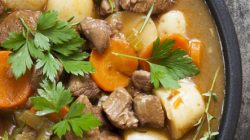Fiber 2.0: Ancient Grains’ High-Fiber, Gluten-Free Options
What’s old is new again.
And while it’s not exactly like bringing a mummy back to life in a Brendan Frasier film, the ancient grains of Egypt and early civilization are once more getting their day in the sun as more and more food choices contain these high-fiber, nutrient-rich options.
According to a report from Food Business News:
“Globally, there is a strong opportunity for ancient grains with half of shoppers interested and nearly 40% saying they use ancient grains at least once a week,” said Cali Amos, research manager for the research firm HealthFocus International. “And of those shoppers interested, more than 20% are willing to pay a premium for products that include ancient grains.”
So, what is considered an ancient grain?
While a strict, textbook definition doesn’t exist, the consensus among mainstream consumers and even the Whole Grains Council, is this: To be considered an ancient grain, you must remain unchanged since the beginning of time.
To that end, we’ve seen many cereals, breads, crackers and flour rely on the kernels of ancient grains to provide nutrient-dense ingredients that are in demand from consumers.
And similar to how we helped you choose healthy fats to improve your diet, Nikken Foods is digging into this trend to help you incorporate these ancient grains into your food. Let’s look at four Gluten-Free Ancient Grains as well as four regular Ancient Grains.
Gluten-Free Ancient Grains:
Quinoa
Technically an edible plant seed, this naturally gluten-free grain is a fiber powerhouse that is already common in modern cuisine. It captured the attention of healthy eaters due to its presence of antioxidants, fiber, protein and amino acids – as well as boasting a low glycemic index which can lead to weight loss and improved metabolic health.
Quinoa can be found in most protein-rich cuisine and makes a tasty partner to salads, porridge or any side dish or rice substitute.
Teff
Considered a super small grain, teff certainly shows up big when it comes to nutritional value and health benefits. High in iron and taste, teff is a gluten-free option for anyone looking to reduce PMS symptoms, lose weight, increase gut health and manage your blood sugar levels.
Teff can be eaten whole, boiled, steamed or baked – making it a great ingredient for pancakes, breads, cereals and more. Its nutty taste has made it a popular addition to Ethiopian dishes.
Millet
Forget for a moment that it’s the main ingredient in bird seed, and you’ll see that this gluten-free group of grains is a very nutrient-rich grain that tastes good and contains heart health properties, cell and body tissue repair benefits and enough magnesium to substantially lower any type 2 diabetes risk.
This prehistoric grain was a staple in Asia and India (and later Europe). Now millet can play a role as a key ingredient in couscous dishes as well as in porridge, bread/muffin recipes or just tossed over your favorite veggies and salads.
Amaranth
This group of more than 60 different species of grains has been cultivated for over 8,000 years – think back to the Inca, Maya and Aztec ages. Rich with antioxidants, protein and fiber, amaranth is a nutritious, gluten-free grain that enhances digestion, reduces cholesterol, increases weight loss and has an anti-inflammatory effect on the body.
Be sure to sprout amaranth first by soaking in water and letting germinate for one to three days, then cook it. It delivers a fiber-rich, protein punch to soups, smoothies and stews – plus it makes them thicker and tastier.
High-Fiber Ancient Grains (that contain gluten):
Barley
A whole grain means that you use/eat the entire wheat kernel (germ, endosperm and bran) and barley is one of the most popular whole grains due to its many health benefits. Made up of vitamins, minerals, antioxidants and fibers, barley lowers blood sugar, insulin levels and kick starts your digestive tract and gut health.
Barley makes for a healthy addition to any diet (if you are gluten tolerant) and can be mixed into salads, side dishes, soups and stews easily.
Bulgur
With a texture similar to quinoa, this edible cereal grain is packed with essential nutrients and fiber which can result in increased heart health, weight loss, blood sugar control and gut health for whoever consumes it.
A versatile grain, bulgur cooks quickly and is often used in Middle Eastern dishes as well as salads, soups and pilafs or as a substitute for rice or couscous.
Kamut
This high-protein grain has been around for centuries and is back in demand due to its size and taste. Two to three times larger than wheat, kamut contains the B vitamins that deliver energy and is relatively weak with gluten. Because it’s rich in fiber, it helps aid digestion and build strong, healthy bones.
Feel free to substitute kamut with most whole grains and make it your go-to for the flour in your pancakes, waffles, breads or pasta.
Spelt
This variety of wheat is very high in gluten and carbs, making it an important source of vitamins, minerals and fiber. Soaking, sprouting and fermenting spelt is a good way to reduce its lectins, FODMAPs and phytic acid content so it’s even healthier. Overall, spelt’s health benefits include reducing obesity, heart disease and type 2 diabetes.
Consider Spelt a suitable substitute for other carbs and spelt flour can even replace wheat flour.
—
If your recipes need a blast from the past to deliver the fiber, protein and vitamins necessary for a balanced diet, visit Nikken Foods and find the all-natural ingredients you’re looking for.

